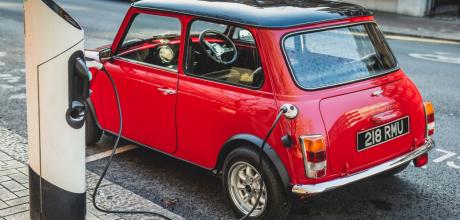Classic industry fits both ICE and EV in its future
The rise of electric cars is at once causing controversy and opportunity in the classic car market. The number of companies converting older vehicles to electric vehicles (EVs) continues to increase, with London Electric Cars, Vital Spark, RBW and Electric Classic Cars just some of the names involved, along with conversions by OEMs. Meanwhile apprenticeships for historic vehicles with internal combustion engines (ICE) are more popular than ever with both applicants and employers.
Converting a classic to electric power is at odds with the FIVA definition of what constitutes an historic vehicle. This stance on originality is also shared by the Federation of British Historic Vehicle Clubs (FBHVC). Still, a show of hands at the recent FBHVC AGM suggested that the majority of clubs would be willing to allow converted classics to remain part of their club, with the Federation’s Research Director suggesting that it was better that they were kept on the road than not at all. However, he also questioned to what extent allowing such vehicles was tampering with heritage assets. This has particular relevance in light of recent FBHVC research which has revealed a decline in the number of UK adults who see historic vehicles as heritage assets. Appreciation amongst 16- to 24-year-olds has dropped by almost half in recent years. Can clubs afford to exclude converted cars at a time when interest is in danger of waning?
Yet, as appreciation for traditional classics remains strong, a door opens for historic vehicle trainees at one end of the skills gap between modern cars and classics. Speaking at the Federation’s AGM, FBHVC Deputy Chairman and Skills Director, Karl Carter, outlined the issue. “We believe there’s going to be a big gap between what we’re doing in the historic side and the electric side and there won’t be anything in the middle,” Karl continued: “and what that really means is that our side will pick up internal combustion engines for what is effectively the next 40 years. We can certainly see a huge opportunity.”
The potential boost in career prospects is extra reassurance for young people keen to become historic vehicle apprentices, with the number of trainees already very encouraging. Following the FBHVC’s classic vehicle restoration course introduced in 2013, the subsequent Heritage Skills Academy at Bicester Heritage in 2016, the Historic Skills Academy (HSA) has grown in strength, with the number of apprentices increasing significantly over the last 12 months despite the pandemic. Indeed, the HSA now has three workshops: two at Bicester and now another at the Brooklands Museum in Surrey, with a total of 170 apprentices in training and it’s set for more.
The demand for more apprenticeships is also coming from the employers themselves. Many are finding that as well as realising financial value within just 12 months, apprentices are proving useful in more nuanced ways. By learning time-honoured skills and techniques, the apprentices are able to repair and rebuild things rather than simply throw them away, often saving businesses money. While the industry is in a state of upheaval, it seems that there will be left assured places for our classics and those who work on them in the future, whether or not they’re electric- or traditionally-powered. Many clubs are also finding that there is space for both.
MG Motor Australia & New Zealand has revealed that the MG Marvel R may arrive down under in 2023, presumably in a second-generation facelift; in China, the model is sold under SAIC’s new ‘R’ brand rather than either MG or Roewe.
Whilst the present Marvel R is a goodlooking vehicle, it seems plausible that part of the facelift to come within the next two years or so may include a closer alignment with the prevailing MG design language. We understand that the European-specification BEV MG5 Estate will not be sold in Australia but the Thai-built MG5 saloon (a very different model which we have covered in recent issues) seems a stronger prospect for that market.
In the meantime, the Australian importer has decided to badge the MG petrol-electric-hybrid HS as the ‘Plus EV’, local CEO Peter Cao telling the media in a press conference in November: “We want to make it clear that our ‘Plus EV’ vehicles feature two independent drive systems: one EV, one petrol.” The company has also announced an initiative effectively to provide, free, up to a thousand EV charge points at hotels and other sites as a way to help ramp up acceptance of the electrified MG range.
Australia is a really important market for MG; well inside the market’s top-ten brands in terms of sales, with just over 32,000 sold in 2021 up to November alone; MG is just 3000 units behind Nissan and Volkswagen and has overtaken Subaru sales in the country. What's more, the MG3, very much the old-stager in the current MG range (it is sold in Australia as an automatic transmission, petrol-engine model only), is the top-selling light car in Australia, whilst the MG ZS leads the small-SUV segment. Meanwhile, the MG ZS EV is the next-best-selling electric car in the country below Tesla models. Hope for a wider range there is well-founded then.
Demand for apprenticeships is increasing amid a shifting of skills in the mainstream automotive industry. The 2022 MG range for Australia and New Zealand; the MG HS PHEV becomes the MG HS ‘Plus EV’. The MG3, MG ZS and MG ZS EV are local top sellers in their respective market sectors.
Parked outside SAIC’s design centre at Anting, China, these three models represent the present trio of related brands: ‘Roewe’, ‘R’ (a new all-electric, up-market range) and ‘MG’ (here represented by the latest MG6 Pro). The black SUV in the centre is essentially the same vehicle now being sold in Europe as the MG Marvel R. The new-generation MG5 is now on sale in Thailand, where it is assembled. Like Australia and New Zealand, Thailand is a right-hand-drive market.


